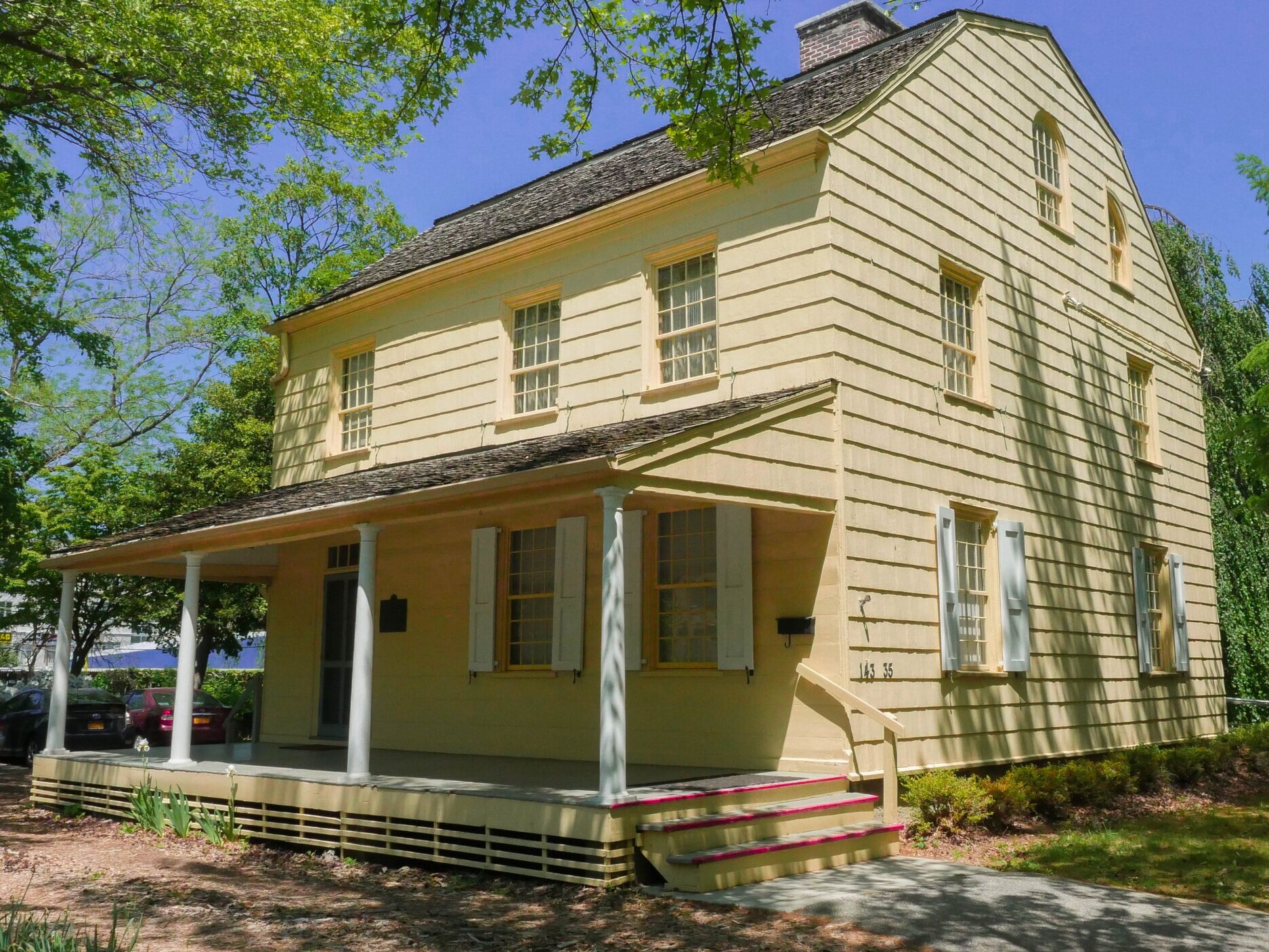Nearby Sites
Society of Friends Meetinghouse, 1936 (Library of Congress Prints and Photographs Division Washington, D.C.)
The Friends Meeting House
137-16 Northern Boulevard, Flushing, NY 11354
The Friends Meeting House is located on Northern Boulevard east of Main Street. The Quakers of Flushing, who for 30 years had met in the Bowne House, built the Meeting House on land acquired by John Bowne in 1692. The first services were held in 1694, when the building was completed. It was enlarged to its present size in 1719. The building has been in continuous use as a place of worship since it was erected, except during the Revolution, when it was used by the British Army for a prison and barracks. The original benches were broken by the British soldiers and used for firewood. Those now in use were installed after the revolution.
Bowne Street Community Church
143-11 Roosevelt Avenue, Flushing, NY 11354
This church is one of the most significant buildings in Flushing and is an important contributor to Bowne Street, which is world renowned for the number and diversity of its houses of worship. Dedicated in 1892, it served two congregations which merged in 1970. The significance of the Bowne Street Community Church lies beyond its architectural merits, as great as they are. Originally built as a Dutch Reformed Church, it is the last link to the community’s history as a Dutch Colony in the mid-17th century, a period associated with the Flushing Remonstrance and John Bowne. As such, it forms a link with the Bowne House, the Flushing Quaker Meeting House and the Flushing Freedom Mile, attractions for tourists from all over the world.
The Community Church has beautiful and significant stained glass windows; these windows were included recently in a lecture program – “The Other Tiffany Girl; Agnes Northrup: Designer of Windows”. The lecture was given by Alice Frelinghuysen, Curator of American Decorative Arts at the Metropolitan Museum of Art. Ms. Northrup (1857-1953) was a resident of Flushing and the most celebrated botanical artist and designer of windows at the Louis C. Tiffany Studios in Corona. Her elaborate landscape and garden scenes are among the most beautiful windows to emerge from the Tiffany Studios. Many of these garden scenes were inspired by Flushing’s gardens and parks. One window reflects a tranquil setting in Kissena Park. Ms. Northrup’s family was prominent in the Flushing community and they were deeply involved in both the church and in a variety of civic projects. The Church was recently designated a NYC Landmark.
The Fox Oaks Stone, c. 1907 (Bowne House Archives)
George Fox Stone
36-40 Bowne Street, Flushing, NY
This stone marks the site where George Fox, founder of the Religious Society of Friends in England, preached in 1672. The sermon was given in John Bowne’s garden, under two large oak trees. These trees were later named “The Fox Oaks.” The stone marks the site of the trees, and is located across Bowne Street from Bowne House in front of the apartment building at 36-40 Bowne Street.
Weeping Beech Park (E. Helmers)
Weeping Beech Park
5729, 143-1 37th Avenue, Flushing, NY 11354
Weeping Beech Park is the site of the first Weeping Beech Tree in America, planted by Samuel Bowne Parsons, Sr. The original tree lived from 1847-1998 and is survived by several sister trees in the park today.
In the mid-nineteenth century, Flushing was a flourishing center for horticulture. In his journal, Samuel Bowne Parsons, Sr. claimed to have established the Parsons Nursery between 1838 and 1840. He traveled extensively to find rare plant materials to bring back to New York City. In 1847, he brought back an oddity from Belgium, the European Weeping Beech, in a small flowerpot. Other notable plant specimens from Parsons, like the Japanese maple, survive at the Bowne House and may be enjoyed by visitors today.
Kingsland Homestead
Kingsland Homestead | Queens Historical Society
143-35 37th Avenue, Flushing, NY 11354
Kingsland Homestead is a Long Island Half-House styled building built in 1785, and in 1968, was the first site in Queens to be made a New York City Landmark. Purchased from his father-in-law, sea-merchant Captain Joseph King bought the house in 1801, and his descendants would live there until the 1930s. The King family, and the related Murray family lived in the house, and ran one of Flushing's many tree nursery businesses.
The house was moved to Weeping Beech Park in 1968 in order to preserve it, where it stands today, as the headquarters of the Queens Historical Society. Today, the Queens Historical Society uses the interior for regularly changing exhibits about the history and culture of Queens.





